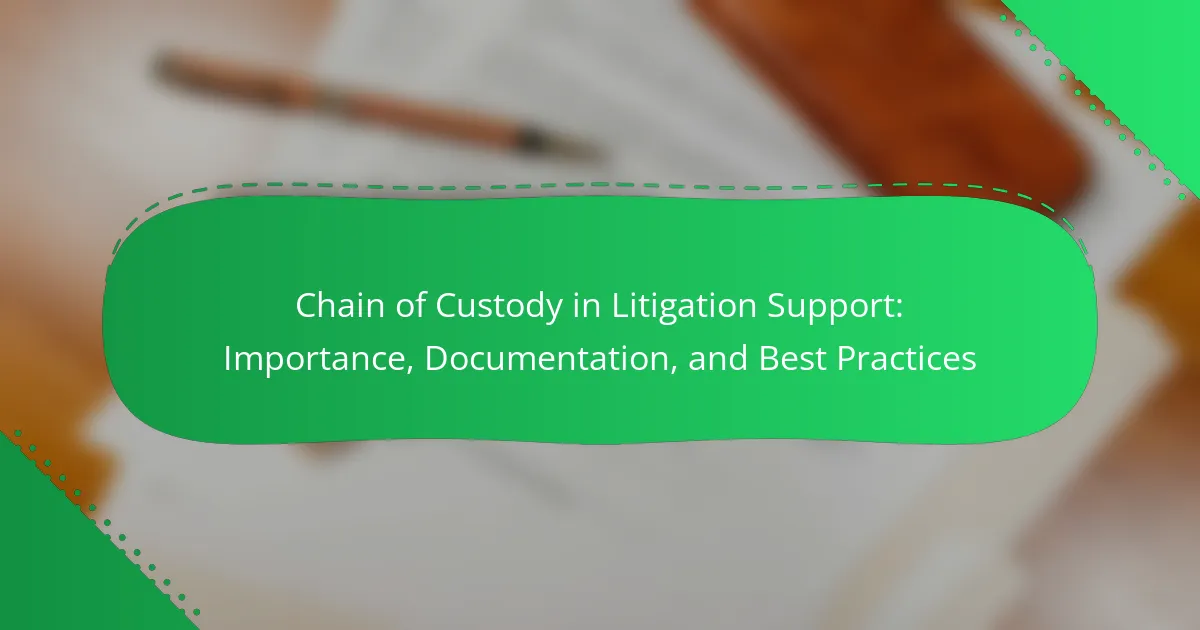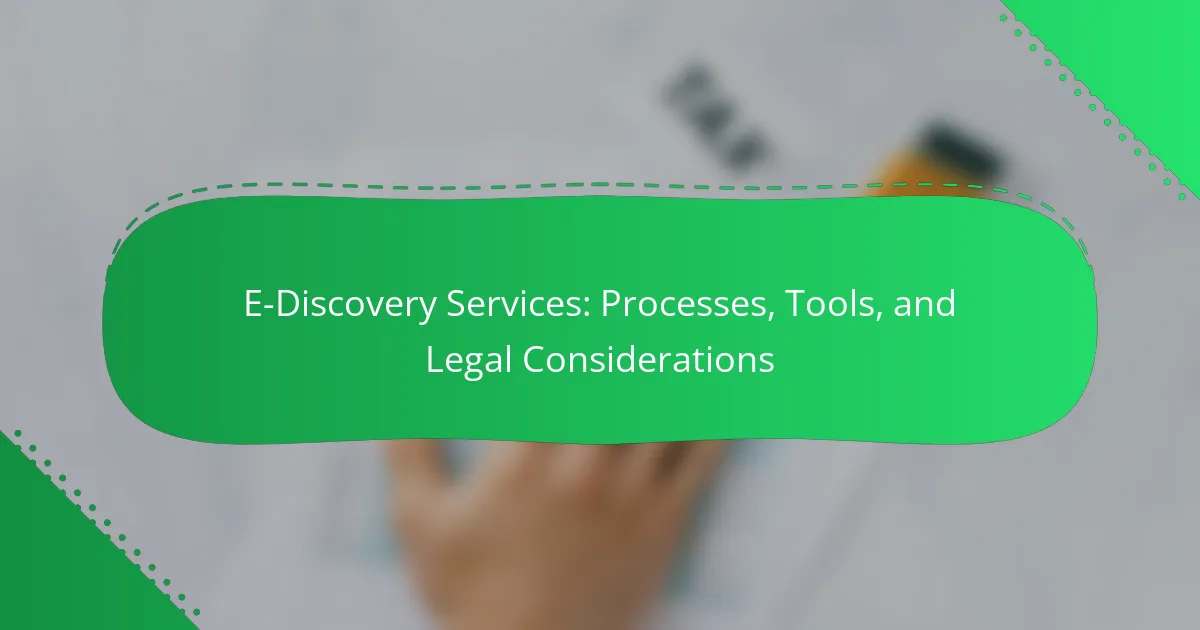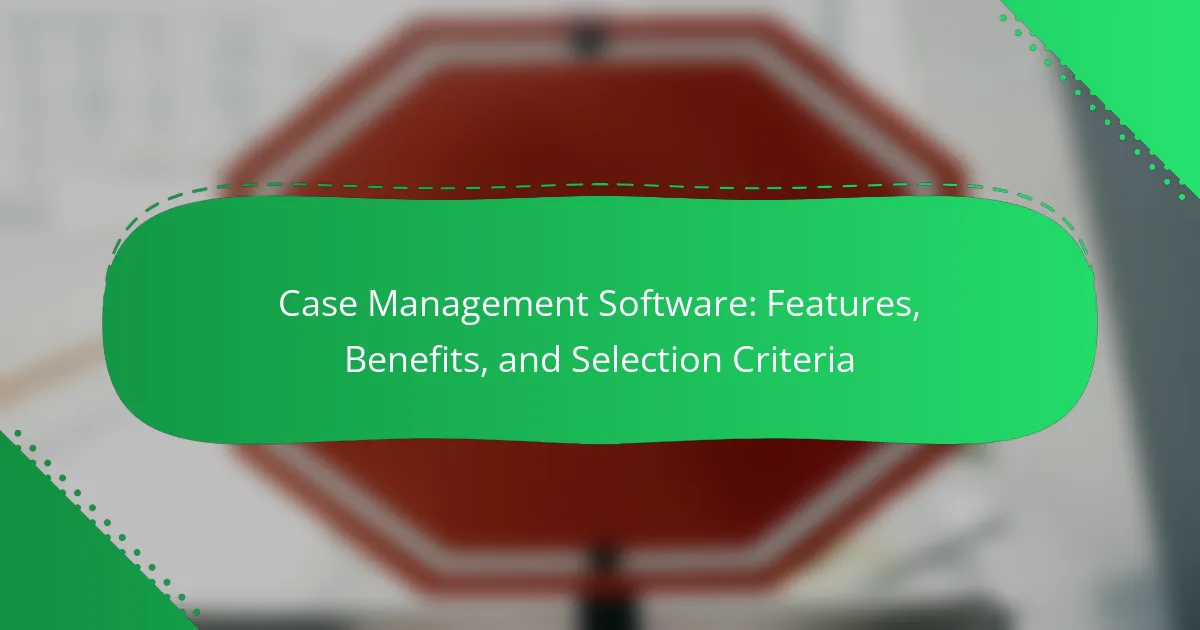Evidence presentation in court is the systematic process of introducing, displaying, and explaining evidence to support legal arguments, essential for establishing facts and persuading judges or juries. This article explores the various tools, techniques, and best practices for effective evidence presentation, including the use of presentation software, document management systems, and courtroom technology. Key elements discussed include the importance of clear organization, visual aids, and storytelling techniques, all aimed at enhancing comprehension and retention of information. Additionally, the article highlights the criteria set by the Federal Rules of Evidence, ensuring that all presented evidence is relevant, admissible, and properly authenticated, thus upholding the integrity of the judicial process.
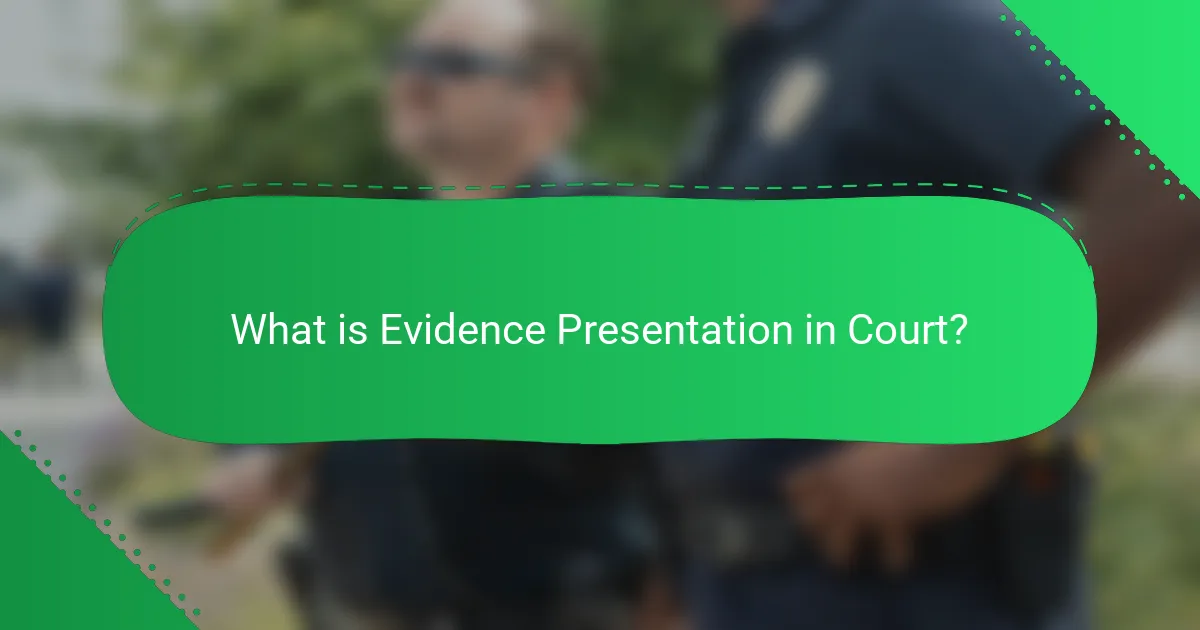
What is Evidence Presentation in Court?
Evidence presentation in court refers to the process of introducing, displaying, and explaining evidence to support a legal argument. This process is crucial for establishing facts and persuading the judge or jury. Evidence can include documents, witness testimonies, photographs, and physical objects. Each piece of evidence must be relevant, admissible, and properly authenticated. The presentation is often structured to follow legal protocols and guidelines. Effective evidence presentation utilizes visual aids and clear explanations to enhance understanding. According to the Federal Rules of Evidence, all evidence must meet specific criteria to be considered valid in court. This ensures a fair trial and upholds the integrity of the judicial process.
How does Evidence Presentation impact legal proceedings?
Evidence presentation significantly impacts legal proceedings by influencing the jury’s perception and decision-making. Clear and organized evidence can enhance understanding and retention of critical information. Conversely, poorly presented evidence can lead to confusion and misinterpretation. According to studies, juries are more likely to favor cases where evidence is visually compelling and logically structured. For example, the use of charts and videos can aid jurors in grasping complex data. Additionally, effective storytelling through evidence can evoke emotional responses that sway jury opinions. Therefore, the manner in which evidence is presented is crucial to the outcome of legal cases.
What types of evidence are commonly presented in court?
Types of evidence commonly presented in court include testimonial evidence, physical evidence, documentary evidence, and digital evidence. Testimonial evidence consists of statements made by witnesses under oath. Physical evidence refers to tangible items that can be examined, such as weapons or clothing. Documentary evidence includes written documents like contracts or emails that support a case. Digital evidence encompasses electronic data, including computer files and text messages. Each type serves to establish facts and support arguments in legal proceedings.
How are different types of evidence evaluated in court?
Different types of evidence are evaluated in court based on their relevance, reliability, and admissibility. Relevance determines if the evidence directly relates to the case at hand. Reliability assesses whether the evidence can be trusted or is credible. Admissibility refers to whether the evidence is allowed under the rules of court. Courts often use established legal standards, such as the Frye or Daubert standards, to evaluate scientific evidence. Testimony from expert witnesses can also influence the evaluation process. Judges ultimately decide the weight and impact of the evidence presented.
Why is effective Evidence Presentation crucial for legal outcomes?
Effective evidence presentation is crucial for legal outcomes because it directly influences the jury’s understanding and perception of the case. Clear and organized presentation helps to establish credibility and relevance. When evidence is presented effectively, it enhances the persuasive power of arguments. Studies show that jurors are more likely to remember and be influenced by well-structured evidence. For example, the National Center for State Courts found that jurors often struggle with complex information. Simplifying evidence through visuals can significantly improve retention and comprehension. Additionally, effective presentation can highlight key points, making them more impactful. Ultimately, the clarity of evidence can determine the success or failure of a legal argument.
What are the consequences of poor Evidence Presentation?
Poor evidence presentation can lead to significant negative outcomes in legal proceedings. It may result in the jury misunderstanding key facts. Miscommunication can weaken a case’s overall argument. This often leads to unfavorable verdicts. For instance, unclear visuals can confuse jurors. Inadequate organization may cause critical evidence to be overlooked. Studies show that jurors are more likely to be swayed by clear, compelling presentations. Thus, poor evidence presentation can directly impact the effectiveness of legal arguments.
How can effective Evidence Presentation influence jury perception?
Effective evidence presentation significantly influences jury perception by enhancing clarity and understanding. Clear and organized evidence helps jurors grasp complex information. Visual aids, such as charts and diagrams, can simplify data interpretation. Engaging storytelling techniques can make evidence more relatable and memorable.
Research shows that jurors are more likely to retain information presented in a coherent narrative. A study by the National Center for State Courts found that jurors often rely on how evidence is presented to form their opinions. Effective presentation can lead to increased persuasion and impact the jury’s decision-making process. Thus, the manner in which evidence is presented directly shapes jurors’ perceptions and conclusions.
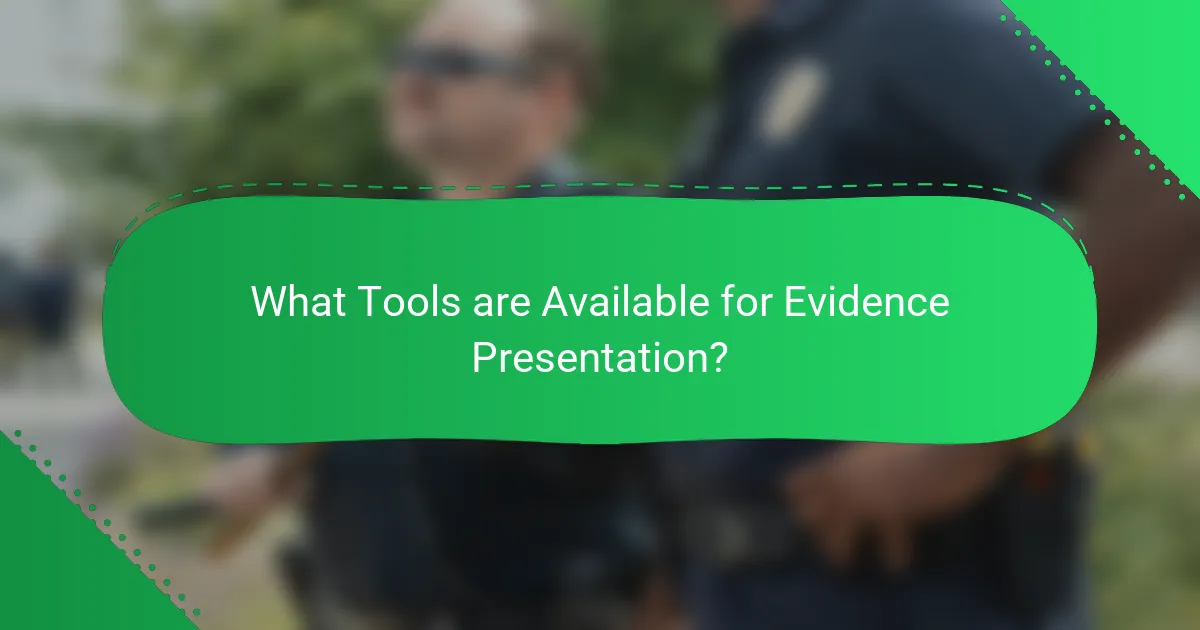
What Tools are Available for Evidence Presentation?
Tools available for evidence presentation include presentation software, document management systems, and courtroom technology. Presentation software like Microsoft PowerPoint allows for visual storytelling. Document management systems help organize and retrieve evidence efficiently. Courtroom technology includes projectors, screens, and video conferencing tools. These tools enhance clarity and engagement during trials. Research shows that effective use of technology can improve juror understanding and retention of information. For instance, a study by the National Center for State Courts highlights the importance of visual aids in legal settings.
What digital tools can enhance Evidence Presentation?
Digital tools that can enhance evidence presentation include presentation software, case management systems, and visual evidence tools. Presentation software like Microsoft PowerPoint allows for structured and visually appealing displays of evidence. Case management systems, such as Clio or MyCase, help organize documents and streamline workflow. Visual evidence tools, including trial presentation software like TrialDirector, enable the integration of multimedia elements. These tools improve clarity and engagement during court proceedings. They also facilitate better understanding and retention of information by jurors and judges. Studies show that visual aids can significantly increase comprehension of complex evidence.
How do presentation software options differ in functionality?
Presentation software options differ in functionality primarily based on features and usability. Different software may offer unique tools for creating visual aids. For instance, some programs provide advanced animation capabilities, while others focus on collaborative features. Certain options may allow for integration with other applications, enhancing versatility. Additionally, user interfaces can vary significantly, impacting ease of use. Some software is designed specifically for legal presentations, offering templates tailored to courtroom needs. Others may prioritize general business use, lacking legal-specific functionalities. Each software’s capabilities can affect the overall effectiveness of evidence presentation in court settings.
What role do visual aids play in Evidence Presentation?
Visual aids enhance evidence presentation by making complex information more accessible. They help clarify key points and support verbal arguments. Visual aids can include charts, graphs, images, and videos. These tools facilitate audience understanding and retention of information. Research shows that people remember visual information better than text alone. A study by the University of Minnesota found that visuals improve comprehension by 89%. Effective use of visual aids can lead to more persuasive presentations in court settings.
What physical tools are essential for presenting evidence?
Essential physical tools for presenting evidence include projectors, display screens, and whiteboards. Projectors allow for visual representation of evidence in a courtroom setting. Display screens provide clarity and enhance visibility for jurors and judges. Whiteboards facilitate real-time explanations and annotations during presentations. Other important tools are document cameras, which can display physical documents digitally. Evidence bags ensure the secure handling of physical evidence. Finally, laptops or tablets are crucial for accessing digital files and presentations. Each of these tools enhances the effectiveness of evidence presentation in court.
How do exhibits and models serve as effective evidence tools?
Exhibits and models serve as effective evidence tools by providing tangible representations of information. They enhance understanding by illustrating complex concepts visually. This visual aid can simplify intricate details for jurors and judges. For instance, a model of a crime scene can clarify spatial relationships and events. Exhibits can include photographs, diagrams, or physical objects relevant to the case. Studies show that jurors retain information better when presented with visual evidence. According to a report by the National Center for State Courts, visual aids can increase juror engagement and comprehension. These factors contribute to more informed decision-making in legal contexts.
What are the best practices for using physical evidence in court?
Best practices for using physical evidence in court include proper collection, storage, and presentation. Evidence must be collected following established protocols to avoid contamination. Chain of custody should be maintained to ensure integrity. Evidence should be clearly labeled and documented at every stage. During presentation, visual aids can enhance understanding. Witnesses should explain the relevance of the evidence. Courts often require evidence to be admissible under rules of evidence. Proper handling can prevent challenges to the evidence’s credibility. These practices help ensure that physical evidence effectively supports a case.
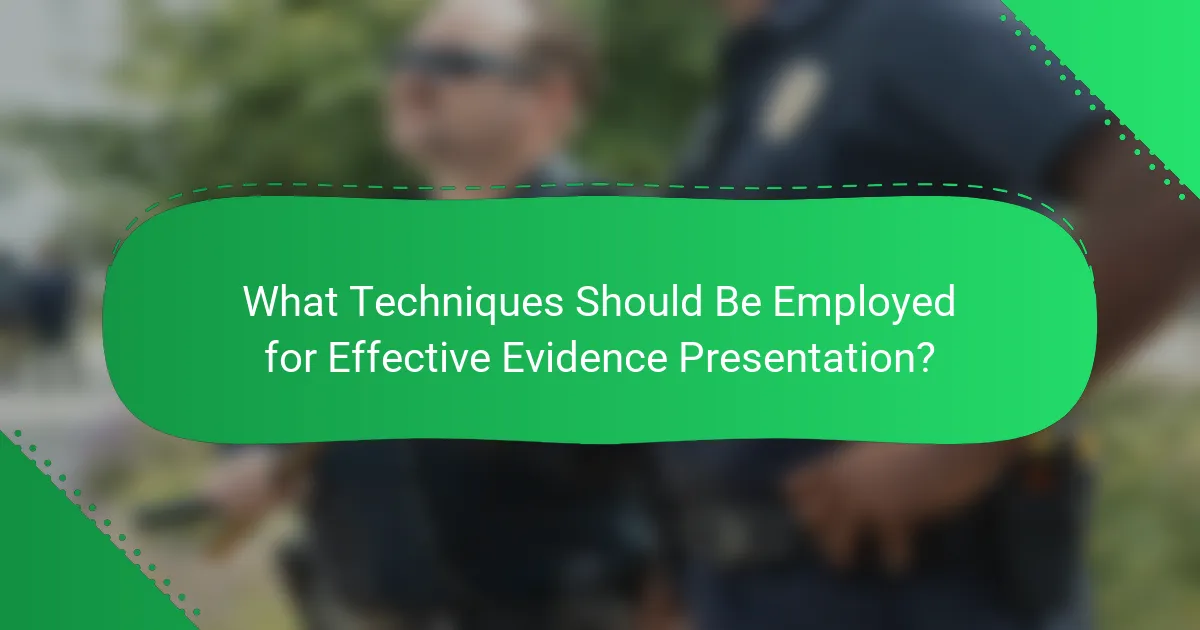
What Techniques Should Be Employed for Effective Evidence Presentation?
Effective evidence presentation techniques include clear organization, visual aids, and storytelling. Clear organization involves structuring evidence logically to enhance understanding. Visual aids, such as charts and diagrams, help to illustrate complex information. Storytelling techniques engage the audience and make the evidence relatable. Use of credible sources strengthens the argument presented. Practice and rehearsal ensure smooth delivery. These methods increase the persuasive impact of the evidence. Research shows that well-structured presentations improve retention and comprehension of information.
How can storytelling enhance Evidence Presentation?
Storytelling can enhance evidence presentation by making complex information more relatable and engaging. It helps to contextualize evidence within a narrative framework. This approach allows audiences to better understand the significance of the evidence. Research shows that stories can improve retention of information by up to 65%. By framing evidence within a story, it becomes easier for jurors to follow the logic and implications. Additionally, storytelling can evoke emotions that may influence decision-making. Effective storytelling can lead to a more persuasive argument, ultimately impacting the outcome of a case.
What techniques can be used to create a compelling narrative?
Techniques to create a compelling narrative include establishing a clear structure, using vivid imagery, and incorporating emotional appeal. A clear structure provides a beginning, middle, and end, guiding the audience through the story. Vivid imagery engages the audience’s senses, making the narrative more relatable. Emotional appeal connects with the audience’s feelings, fostering empathy. Additionally, using real-life examples or case studies can enhance credibility. According to research, narratives that incorporate these elements are more memorable and persuasive, as demonstrated in studies on storytelling in legal contexts.
How does emotional appeal factor into Evidence Presentation?
Emotional appeal significantly influences evidence presentation in court. It helps to engage jurors and create a connection to the case. Jurors are more likely to remember and be persuaded by evidence that resonates emotionally. This connection can enhance the perceived credibility of the evidence presented. For instance, emotionally charged testimonies can evoke sympathy or outrage, impacting juror decisions. Research shows that jurors often rely on their emotions when making judgments. A study by the American Psychological Association found that emotional narratives can sway juror opinions more than factual evidence alone. Therefore, emotional appeal is a critical component in effectively presenting evidence in court.
What are the best practices for organizing evidence during trials?
The best practices for organizing evidence during trials include categorizing evidence clearly. Evidence should be grouped by type, relevance, and chronology. This helps in easy retrieval and presentation. Utilizing binders or digital folders can enhance organization. Each piece of evidence should be labeled with a clear description. Maintaining a detailed index or inventory is also crucial. This allows for quick reference during the trial. Consistency in formatting and labeling aids in clarity. Following these practices improves the overall efficiency of evidence presentation.
How can chronological organization improve clarity in presentation?
Chronological organization enhances clarity in presentations by structuring information in a time-based sequence. This format allows audiences to follow the progression of events easily. It helps in establishing cause-and-effect relationships clearly. When details are presented in order, it minimizes confusion regarding timelines. Studies show that people retain information better when it is organized chronologically. This is especially important in legal contexts, where timelines can be pivotal to understanding cases. Therefore, chronological organization is a key technique for effective evidence presentation.
What methods can be used to ensure evidence is easily accessible?
Digital databases can be used to ensure evidence is easily accessible. These databases organize evidence systematically for quick retrieval. Cloud storage solutions enhance accessibility by allowing remote access. Document management systems streamline the organization of files and records. Search functionalities enable users to locate specific evidence rapidly. Training staff on these systems improves overall efficiency in evidence handling. Regular updates and maintenance of systems ensure continued accessibility. Collaboration tools facilitate sharing of evidence among legal teams.
What common pitfalls should be avoided in Evidence Presentation?
Common pitfalls in evidence presentation include lack of clarity, which can confuse the audience. Overloading slides with text makes key points hard to grasp. Failing to organize evidence logically can disrupt the flow of the argument. Ignoring the audience’s perspective may lead to disengagement. Using technical jargon without explanation can alienate non-expert viewers. Not practicing the presentation can result in poor delivery and timing issues. Lastly, neglecting to verify the authenticity of evidence can damage credibility. Each of these pitfalls undermines the effectiveness of evidence presentation in court.
How can overloading with information detract from effectiveness?
Overloading with information can detract from effectiveness by overwhelming the audience. When too much information is presented, it becomes difficult for individuals to process and retain key points. This cognitive overload can lead to confusion and disengagement. Research indicates that people can only hold a limited amount of information in working memory. For instance, Miller’s Law suggests that the average number of objects an individual can hold in working memory is about seven. Consequently, exceeding this limit can hinder comprehension and decision-making. In court settings, clear and concise evidence presentation is crucial for jurors to understand and evaluate arguments effectively.
What are the risks of misrepresenting evidence in court?
Misrepresenting evidence in court can lead to severe legal consequences. It may result in a loss of credibility for the presenting party. Courts rely on accurate evidence to make fair decisions. Misrepresentation can also lead to wrongful convictions or acquittals. Legal penalties may include fines or sanctions against the attorney involved. In some cases, it can result in criminal charges for perjury. The integrity of the judicial system is compromised with false evidence. Ultimately, misrepresentation undermines the pursuit of justice.
What are the key best practices for successful Evidence Presentation?
Key best practices for successful evidence presentation include clarity, organization, and engagement. Clarity ensures that the evidence is easily understood by the audience. Using simple language and avoiding jargon helps achieve this. Organization involves presenting evidence in a logical sequence. A structured approach aids in following the argument. Engagement captures the audience’s attention and maintains interest. Utilizing visuals, such as charts or images, enhances understanding. Practicing delivery is crucial for confidence and smooth presentation. Tailoring the presentation to the audience’s knowledge level ensures relevance. Lastly, anticipating questions prepares the presenter for audience interactions. These practices contribute to effective communication of evidence in court settings.
How can preparation and rehearsal improve presentation outcomes?
Preparation and rehearsal significantly enhance presentation outcomes. They allow presenters to organize their thoughts clearly. This clarity leads to more coherent delivery during the actual presentation. Research indicates that well-prepared speakers are perceived as more credible and authoritative. A study published in the Journal of Business Communication found that rehearsed presentations scored higher in audience engagement. Additionally, rehearsal helps identify potential challenges in the presentation. This proactive approach reduces anxiety and boosts confidence. Effective preparation also enables the speaker to anticipate audience questions and reactions. Ultimately, these practices contribute to a more persuasive and impactful presentation.
What strategies can be implemented to engage the court audience?
Engaging the court audience can be achieved through various strategies. First, utilizing clear and concise language helps maintain attention. Jurors and judges appreciate straightforward communication. Second, incorporating visual aids, such as charts or videos, can enhance understanding. Visuals support verbal information and make complex evidence more accessible. Third, storytelling techniques can make presentations more relatable. Narratives help humanize cases and evoke emotional responses. Fourth, interactive elements, like asking questions, can involve the audience. This encourages active participation and keeps focus. Lastly, rehearsing presentations ensures smooth delivery. Preparation builds confidence and reduces errors during court proceedings. These strategies collectively enhance audience engagement in the courtroom.
Evidence presentation refers to the systematic process of introducing and explaining evidence in court to support legal arguments, which is essential for establishing facts and persuading judges or juries. The article covers the impact of evidence presentation on legal proceedings, various types of evidence, evaluation criteria, and the significance of effective presentation techniques. It also discusses tools and best practices, including the use of visual aids and storytelling, to enhance clarity and engagement. Additionally, the article outlines common pitfalls to avoid and strategies for successful evidence presentation, emphasizing the importance of preparation and organization in achieving favorable legal outcomes.

